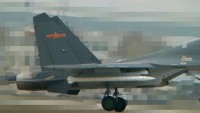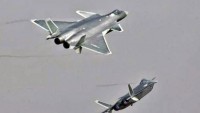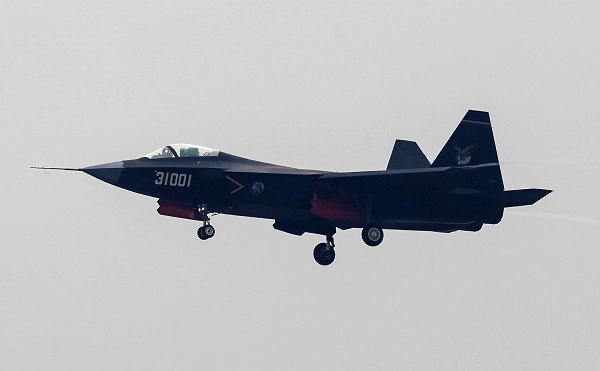China’s Military Shedding Copycat Notoriety; Developing Better Indigenous Advanced Technologies
| Arthur Dominic Villasanta | | Feb 18, 2017 12:17 AM EST |
(Photo : Reuters) A J-31 stealth fighter, which looks a lot like the U.S. F-35 it copied.
China is moving from being infamous as a copycat and purloiner of military technologies from the West into a nation that seems to be reaching "near-parity with the West," especially in the aerospace realm.
This according to "The Military Balance 2017," the latest edition of the much awaited annual assessment of global military capabilities and defense economics published by the International Institute for Strategic Studies (IISS) in London.
Like Us on Facebook
Released only this week, The Military Balance 2017 reckons that Western military technological superiority "is increasingly challenged" by China.
"We now judge that in some capability areas, particularly in the air domain, China appears to be reaching near-parity with the West," said the report.
The report noted that for decades China was only capable of copying Soviet-era or Russian weapons or technologies. Today, however, China has shifted to the domestic research, development and manufacture of weapons and technologies, supported by sustained military spending.
China's military budget is 1.8 times larger than those of South Korea and Japan combined and accounts for more than a third of Asia's total military spending in 2016.
The report claims China is now seen as a "pacing threat" to the U.S. in aerospace technologies. It noted that the People's Liberation Army Air Force (PLAAF) has just introduced into service the "PL-10," a short-range air-to-air missile only a few countries have been able to develop.
The PL-10 is unique in that it can be slaved to a Helmet Mounted Display (HMD), a system only used by a few fighters such as the Lockheed Martin F-35 Joint Strike Fighter and the Russian Sukhoi S-35 air superiority fighter.
The HMD allows a pilot to track a target beyond the aircraft's radar scan envelope using the missile's high off-boresight capability, achieved by the pilot turning his head towards the target to lock-on.
China is also developing what might be the world's longest range air-to-air missile, aptly called the "Very Long Range Air-to-Air Missile" or VLRAAM.
VLRAAM is being developed to shoot down strategically important but slow and unarmed U.S. aerial tankers and airborne early warning and control aircraft (AEW&C), and not faster stealth fighters such as the F-35 flown by the U.S. Navy and Marine Corps.
Chinese state-controlled media revealed VLRAAM is over six meters long compared to the 3.6 meter length for the Advanced Medium Range Air-to-Air Missile (AMRAAM) currently in use by the United States military. VLRAAM has a diameter of 33 cm compared to AMRAAM's 18 cm.
News stories and photos showed one of these VLRAAMs mounted beneath each wing of a Shenyang J-16 fourth generation, multirole fighter bomber during tests. Chinese sources said the missile is incompatible with China's new stealth fighters, the Chengdu J-20 and the Shenyang J-31.
This disadvantage means the easily detectible J-16 can be easily engaged at long range by U.S. fighters such as the F-35 or the F/A-18 E/F Super Hornets flown-off U.S. Navy aircraft carriers. The two-seat J-16 has a round trip range of 3,900 km.
Tagschina, copycat, The Military Balance 2017, International Institute for Strategic Studies (IISS), People's Liberation Army Air Force, PL-10, Very Long Range Air-to-Air Missile, VLRAAM
©2015 Chinatopix All rights reserved. Do not reproduce without permission
 China Goes on Propaganda Offensive Promoting its Very Long Range Air-to-Air Missile
China Goes on Propaganda Offensive Promoting its Very Long Range Air-to-Air Missile China’s Air Patrols now have to Contend with US Marines F-35B Squadron based in Japan
China’s Air Patrols now have to Contend with US Marines F-35B Squadron based in Japan F-35 Pilots will Quickly Wipe-out the PLA Naval Air Force in a South China Sea War
F-35 Pilots will Quickly Wipe-out the PLA Naval Air Force in a South China Sea War China’s Military Lists Weapons the United States Should Fear
China’s Military Lists Weapons the United States Should Fear
EDITOR'S PICKS
-

Did the Trump administration just announce plans for a trade war with ‘hostile’ China and Russia?
-

US Senate passes Taiwan travel bill slammed by China
-

As Yan Sihong’s family grieves, here are other Chinese students who went missing abroad. Some have never been found
-

Beijing blasts Western critics who ‘smear China’ with the term sharp power
-

China Envoy Seeks to Defuse Tensions With U.S. as a Trade War Brews
-

Singapore's Deputy PM Provides Bitcoin Vote of Confidence Amid China's Blanket Bans
-

China warns investors over risks in overseas virtual currency trading
-

Chinese government most trustworthy: survey
-

Kashima Antlers On Course For Back-To-Back Titles
MOST POPULAR
LATEST NEWS
Zhou Yongkang: China's Former Security Chief Sentenced to Life in Prison

China's former Chief of the Ministry of Public Security, Zhou Yongkang, has been given a life sentence after he was found guilty of abusing his office, bribery and deliberately ... Full Article
TRENDING STORY

China Pork Prices Expected to Stabilize As The Supplies Recover

Elephone P9000 Smartphone is now on Sale on Amazon India

There's a Big Chance Cliffhangers Won't Still Be Resolved When Grey's Anatomy Season 13 Returns

Supreme Court Ruled on Samsung vs Apple Dispute for Patent Infringement

Microsoft Surface Pro 5 Rumors and Release Date: What is the Latest?










